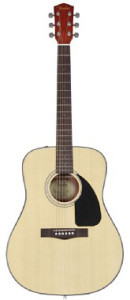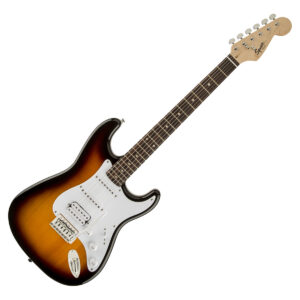Guitar Recommendations
- Don’t buy a Gear4Music own brand guitar (sometimes called SubZero)
- Avoid ‘Martin Smith’ guitars too (sometimes sold from Argos)
- You tend to get what you pay for
- Don’t spend less than £90-ish on a guitar or amp
- If you’re having lessons, I’d be happy to do a quick scan of the options on Ebay or Facebook marketplace for you
A lot of pupils ask me what guitar they should purchase. If you’re a beginner, then being ‘easy to play’ is possibly the most important aspect. In the last 10 years, factory-made budget beginner guitars have come a long way in terms of quality and value for money.
I’ve concentrated mainly on starter/beginner guitars on this page, as better players will possibly want something more specific to their tastes/style. I’ve chosen well known brands that hold their second hand value well. I’ve also included a lot of links to the Gear 4 Music website. They are a great independent music shop with good prices. However, they sell a lot of cheap ‘Gear 4 Music’ branded equipment that is absolutely awful. Don’t ever buy these. They are sometimes listed as ‘SubZero’.
Adult Acoustic Guitars
 With steel strings – If you are looking for an adult acoustic guitar, the first one to look at would be a Yamaha F310, or if you can spend a little more the Sigma DM-ST is excellent. The Yamaha FX370C has the ability to plug into speakers and/or a PA system – if you are willing to spend a little more.
With steel strings – If you are looking for an adult acoustic guitar, the first one to look at would be a Yamaha F310, or if you can spend a little more the Sigma DM-ST is excellent. The Yamaha FX370C has the ability to plug into speakers and/or a PA system – if you are willing to spend a little more.
With nylon strings – If you wanted a classical guitar, then you could go for a Yamaha C40 or a Hartwood Renaissance. The nylon strings are easier on the fingers, but do not suit contemporary music as well – rather more traditional, classical, spanish or folk styles.
Children’s Guitars
 With nylon strings – Children’s guitars tend to be slightly smaller, and also usually have nylon strings which are a little easier on the fingers for young hands. An excellent 3/4 sized guitar is the Yamaha CS40. I highly recommend not buying anything cheaper than this – it’s not just the inferior sound, they also tend to be harder to play.
With nylon strings – Children’s guitars tend to be slightly smaller, and also usually have nylon strings which are a little easier on the fingers for young hands. An excellent 3/4 sized guitar is the Yamaha CS40. I highly recommend not buying anything cheaper than this – it’s not just the inferior sound, they also tend to be harder to play.
With steel strings – harder on the fingers but have a more modern sound. Again Yamaha have some great options (like the JR1 if budget is an issue), but I’d recommend going for the Yamaha JR2S if you can, which has a softer sounding spruce top. This Yamaha one can also plug into a PA system/speakers which is useful.
Children’s electric guitars – if a child especially wanted to play electric guitar then I’d have no problem with that as the extra enjoyment might mean they would practice a lot more. A decent budget 3/4 sized guitar is the Squire Mini Strat. If you’re willing to spend more, you can also get an Epiphone pack here which includes a case and accessories, or the Brian May Mini here. Also, see notes in the electric guitar section above about whether to buy an amp. Full size electric guitars are slightly easier for children to play than full size acoustics, so if you’re roughly 9/10+ it might be worth skipping the child-size guitar.
Half size (very young) – For very young children (approx ages 5-7) it might be worth starting out with a 1/2 sized guitar like the Encore Classical.
Electric Guitars
 There is a huge variety of electric guitars out there, some with very unique shapes and sounds. For your first electric, I do recommend getting a fairly ‘standard’ variety. There are two famous makes of electric guitar; Fender and Gibson. Their most popular models are the Stratocaster and Les Paul. As such, their sound is very familiar, very versatile and there is a huge range to choose from. A lot of guitars from other manufacturers are often based on one of these two models as well.
There is a huge variety of electric guitars out there, some with very unique shapes and sounds. For your first electric, I do recommend getting a fairly ‘standard’ variety. There are two famous makes of electric guitar; Fender and Gibson. Their most popular models are the Stratocaster and Les Paul. As such, their sound is very familiar, very versatile and there is a huge range to choose from. A lot of guitars from other manufacturers are often based on one of these two models as well.
Some starter electric guitars:
- Squier Stratocaster – cheap, but solid – this version features a special pickup which can make it more adaptable.
- Epiphone Les Paul 100 – an alternative classic guitar
If you have a specific type of sound you want to make and have a good ear, it could be a good idea to look at second hand guitars. It’s hard to get a bargain with Fender/Gibson as they keep their value so well, but with the lesser known manufactures it’s definitely possible to get a bargain. Ebay, Facebook market and Reverb.com all have listings you can search for by area.
At some point, you will also need something to amplify your electric guitar so that you can hear it properly. Although I do recommend spending most of your budget on the actual guitar. The absolute minimum I would get is the Fender Champion which is 20 watts. Anything less than that isn’t worth it. If you can stretch to it, the Fender Mustang range is fantastic and includes some very smart modelling and effects.
If you’re not able to spend around £120 on an amp then I recommend NOT getting a cheaper one, or an amp in a starter guitar package. They don’t sound great. You can actually play an electric guitar without using an amp, although it does sound very quiet. Or you could purchase a headphone amp like this one, and then use some wired headphones or a wired speaker that you already own. And then you could aim to buy an amp further down the line.
If you have access to a mac computer, then a cable like this will connect your guitar to Garageband and you can play through a huge range of amps and effects.
Accessories
A capo is often needed, and rarely comes in any starter packs. The PPanda Capos are incredibly cheap and do a better job than most, or for a little more quality you could go for the Planet Waves Tri-Action.
I use Dunlop MaxGrip picks. For beginners, you should aim for between .60 and .75mm thickness.
There is little point in buying a separate guitar tuning device as you can get apps for your phone/tablet that do the job just as well. The app Guitar Tuna (available for Apple and Android devices) makes it very easy to learn how to tune your instrument.
Another useful app to have is one that you can use for speeding up or slowing down backing tracks. I will often email tracks at an appropriate speed, but you might want to change these yourself. Anytune is excellent and can be used on any platform. The one I use in lessons is called Capo (Mac only). Or if you have a Windows PC, you can sometimes use Windows Media Player to do it – instructions here.
